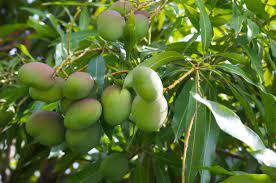
Climbing Mango Trees and Other Summer Pursuits
by Rosie Francis
Summer. Growing up in India, this was my favorite season. The days were long and filled with food, friends, and books. It was a special time for another reason also: summer was mango season. In our home, this meant a ready and steady supply of fresh mangoes straight from the tree. My childhood home was located in what was formerly a mango grove, and every house in our neighborhood had at least one mango tree; our home was supremely fortunate to have not one but four full-grown mature trees. Much of my summer was spent climbing these trees with my siblings and our friends.
The mango trees played a significant role in my childhood. From the time the trees began to bud in April, we waited with eager anticipation for the many ways the fruits would make their delicious appearance in our meals. In particular, we waited for the pickling season when my mother would pickle unripe, green mangoes in a blisteringly hot chili sauce. The pickled mangoes would be stored in stone jars that were always topped off with at least an inch of oil as a way to create an air and moisture lock to prevent fungal growth. With proper care that included periodically setting the jars in the sun, the pickles would last us all year. They were especially appreciated in the monsoon season when the skies opened and heavy rains flooded the city. Even in the summer, an afternoon lunch at home always included rice, yogurt, and mango pickle. The salt, fat, acid, and heat combined to create a dish that was genius in its simplicity, and perfection to the taste buds. I have family members that still make these pickles, and gift me with a bottle or two when I visit. Every taste transports me instantly to those warm summer days when my mother’s kitchen would be filled with the aroma of red chilies, sesame oil, and mustard as she assembled the pickles.
Salt, fat, acid, and heat brings me to the library connection I want to make - namely to the book with that title: Samin Nosrat’s “Salt, Fat, Acid, Heat – Mastering the Elements of Good Cooking”. This cookbook like the curd (yogurt) rice with hot mango pickle is genius in its premise that all foods can be distilled to four elements - salt, fat, acid, and heat. By adjusting these elements anyone can cook delicious food. Nosrat also has a show on Netflix by the same name, and both the show and the book are extremely approachable and authentic. Nosrat, with her infectious laugh and relaxed attitude to cooking, believes that making and sharing food is about creating connections and building community. Few things can be as fundamentally uniting as food.
Another cookbook author and presenter that I have followed for many years is Madhur Jaffrey. Jaffrey’s attitude to cooking and her recipes are similar to Nosrat’s, that good food is about simple ingredients that combine to create something spectacular; not just because of the delicious flavors, but because of the people we share our meal with and the stories we tell. At the Ames Public Library, we have several cookbooks written by Jaffrey; I encourage you to check them out.
As I conclude this column I invite you to try something new this summer; if chili mango pickles sound too spicy for your taste, try one of Nosrat’s or Jaffrey’s fabulous recipes. Whatever meal you do make, I hope you have a chance to share it with people you love. Sharing food can be a great way to build trust, engage in storytelling, and create community. Bon appétit everyone!